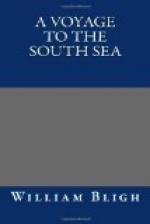August. Wednesday 13.
In latitude 44 degrees 16 minutes south, longitude 122 degrees 7 minutes east, I observed the variation of the compass to be 6 degrees 23 minutes west. I had no opportunity to observe it again till in the latitude of 43 degrees 56 minutes south, longitude 133 degrees 16 minutes east, when it was 1 degree 38 minutes east; so that we had passed the line of no variation. In 1780, on board the Resolution in latitude 44 degrees 23 minutes south, longitude 131 degrees 28 minutes east, the variation was observed 6 degrees 0 minutes west, which is a remarkable difference. We had much bad weather with snow and hail, and in our approach to Van Diemen’s Land nothing was seen to indicate the nearness of the coast, except a seal, when we were within the distance of 20 leagues.
Tuesday 19.
At ten o’clock this afternoon we saw the rock named the Mewstone, that lies near the south-west cape of Van Diemen’s Land, bearing north-east about six leagues. The wind blew strong from the north-west. As soon as we had passed the Mewstone we were sheltered from a very heavy sea which ran from the westward. At eight o’clock at night we were abreast of the south cape when the wind became light and variable. Saw several fires inland.
The Mewstone is a high bold rock that lies five leagues to the south-east of the south-west cape and is the part that all ships bound this way should endeavour to make. Its latitude is 43 degrees 46 or 47 minutes. Several islands lie to the northward between that and the main, among which, bearing north by west from the Mewstone, is a high rock much resembling it; and north-north-east from the Mewstone, on the mainland, is a remarkable high mountain, which in this direction appears notched like a cock’s comb; but as viewed from the eastward seems round.
Wednesday 20.
All the 20th we were endeavouring to get into Adventure Bay but were prevented by variable winds. The next morning at five o’clock we anchored in the outer part, and at sunrise weighed again: at noon we anchored well in the bay and moored the ship, Penguin Island bearing north 57 1/2 degrees east, about two miles distant; Cape Frederic Henry north 23 degrees east; and the mouth of the Lagoon south 16 degrees east.
In our passage from the Cape of Good Hope the winds were mostly from the westward with very boisterous weather: but one great advantage that this season of the year has over the summer months is in being free from fogs. I have already remarked that the approach of strong southerly winds is announced by many kinds of birds of the albatross or petrel tribe, and the abatement of the gale, or a shift of wind to the northward, by their keeping away. The thermometer also very quickly shows when a change of these winds may be expected by varying sometimes six and seven degrees in its height. I have reason to believe that, after we passed the island St. Paul, there was a westerly current; the ship being every day to the westward of the reckoning, which in the whole, from St. Paul to Van Diemen’s land, made a difference of four degrees between the longitude by the reckoning and the true longitude.




